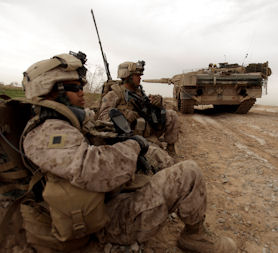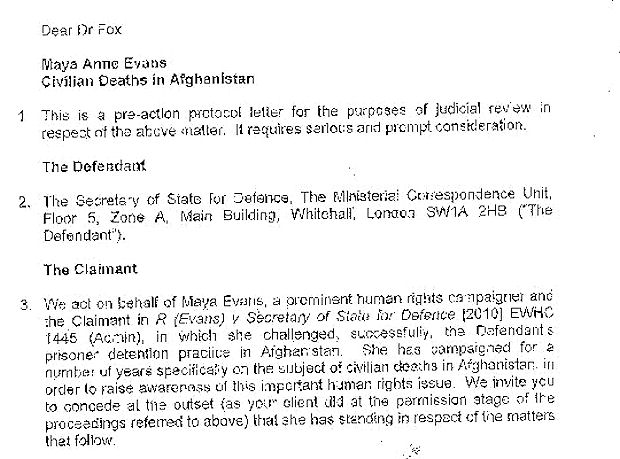WikiLeaks killings: UK troops face legal challenge
Campaigners have launched a bid to take the MoD to court over alleged civilian killings by British forces in Afghanistan, uncovered by Wikileaks. Channel 4 News has obtained the legal letter.

The campaigners are pushing for a full judicial investigation into alleged attacks on Afghan civilians by British forces, made public by Wikileaks’ publication of secret US military files.
A legal letter was sent to defence secretary Dr Liam Fox on Friday by lawyer Phil Shiner of Public Interest Lawyers, on behalf of peace campaigner Maya Evans.
The letter, obtained by Channel 4 News, say the attacks on civilians “require to be investigated as suspected war crimes” under international legislation.
Mr Shiner said: “We know that British forces killed many Iraqis in custody so it is not surprising to read about indiscriminate attacks on Afghan civilians.
“It beggars belief that the Ministry of Defence has the arrogance to refuse to explain these documents, let alone initiate a proper investigation.
“This case is designed to make them hold a public investigation.”
More on the Wikileaks Afghan and Iraq documents from Channel 4 News
The letter documents 21 incidents, seemingly a mix of accidental airstrikes and shootings where civilians came too close to military convoys, and warning shots were fired.
It claims the Wikileaks files: “Identify, inter alia, the killing of at least 26 civilians and the wounding of a further 20 civilians in Afghanistan by British forces.”
It is understood that the campaigners believe these incidents are the “tip of the iceberg” for civilian deaths in Afghanistan, and any inquiry would have to take into account other deaths.
The incidents listed in the Wikileaks documents, which were effectively a history of the Afghanistan conflict from 2004-2009 detailed in US military cables, have not been disputed by the Ministry of Defence, and as such could provide uncontested evidence for the case.
An MoD spokesman told Channel 4 News it would be inappropriate to comment at this time.
The letter from the human rights campaigners to defence secretary Dr Liam Fox

The victims listed in the case appear to include 16 children, at least three women and one mentally ill man.
The letter says “the published incidents add to the already growing concern regarding civilian casualties in Afghanistan.”
What are the laws which military operations must abide by?
In the Geneva Convention of 1949 are the international treaties that contain the most important rules limiting the barbarity of war. Essentially they are the core of international humanitarian law.
In article three of the Geneva Convention 1949, it states: "Persons taking no active part in the hostilities, including members of armed forces who have laid down their arms and those placed hors de combat by sickness, wounds, detention, or any other cause, shall in all circumstances be treated humanely."
The rule that civilians must under no circumstances become the direct target of an attack, as reiterated in art.8(2)(e)(i) of the 1998 Rome Statute of the International Criminal Court, is fundamental to the established law of armed conflict and undoubtedly part of established customary international law.
According to the UN Assistance Mission in Afghanistan, there were 596 civilian deaths caused by international troops and the Afghan National Security Forces in Afghanistan in 2009.
This represents 25 per cent of the total of 2,412 civilians killed – the highest of any year since the fall of the Taliban regime in 2001.
However, this did represent a reduction of 28 per cent in the number of deaths attributed to international forces in 2008, as a result of measures taken to conduct military operations in a manner that would reduce the risk posed to civilians, the document said.
Wikileaks founder Julian Assange has already said that there could be evidence of war crimes in the documents his website released last week.
He said: “I can only speak about this issue in general, however it is up to a court to decide, clearly whether something is in the end a ‘crime’. That said prima-facie, there does appear to be evidence of war crimes in this material.”
International lawyers also suggested to Channel 4 News that there could be further legal challenges.
The executive director of the International Bar Association, Mark Ellis, reviewed detailed evidence surrounding one incident in Jalalabad sent to him following a Channel 4 News examination which found the “military” facts did not appear consistent with human rights group findings.
Mr Ellis said in his opinion there is “prima-facie” evidence from the military logs of the incident involving US Marines that suggests “the troops could be investigated for war crimes, because of the way civilians were targeted and killed.”
Full list of incidents involving the British military and civilians in Afghanistan outlined in a legal letter to defence secretary Dr Liam Fox, pushing for an investigation from human rights campaigners. The incidents were revealed in a Wikileaks publication of US military cables.
Channel 4 News has seen the classified documents but has been unable to independently verify their authenticity.
2006
15 November, Helmand: A Royal Marines Commando patrol in Helmand fired "warning shots" at a vehicle. Two civilians were killed and two wounded, including a child.
2007
4 October, Kabul: An unidentified UK squad wounded a civilian with "two or three" bullets from a "warning shot" in Kabul.
21 October, Kabul: An unidentified UK vehicle "with a gunner on top" wounded three civilian interpreters in a private security company vehicle in Kabul. The US log records: "Investigation is controlled by the British. We are not able to get the complete story."
25 October, Kabul: A vehicle failed to stop for an unidentified patrol. A "warning shot" was fired by a British soldier "which ricocheted and struck a non-combatant", injuring him.
6 November, Kabul: The son of an Afghan general was killed by a "warning shot" from an unidentified UK company on the day of his brother’s wedding, in Kabul. The US log records: "There could be some demonstration…The family will get the dead body tomorrow."
2008
12 March, Helmand: Ambushed troops called in helicopter gunships after a soldier was wounded. Three enemy were claimed to be killed. However the bodies of two women and two children were later found, plus a wounded child.
14 October, Helmand: Y Company 45 Commando Royal Marines hit a motorcyclist at a roadblock with what is stated to be a "warning shot" ricochet.
22 October, Helmand: A soldier in a British squad in Helmand mentoring the Afghan army killed a motorcyclist for "driving at speed" towards them. The log states: "he believed the LN [local national] was a suicide bomber."
19 November, Helmand: Soldiers from J Company, 42 Commando Royal Marines fired "warning shots" at a vehicle approaching convoy. A child is killed.
29 November, Helmand: A police patrol mentored by UK troops shot at a vehicle driven by another Afghan policeman. His daughter is shot in the leg.
4 December, Helmand: W Company, 45 Commando Royal Marines, shoot and wound a man stated to have been identified as a possible "spotter". They then are reported to have discovered that "this was an LN [local national] not an insurgent."
24 December, Helmand: L Company, 42 Commando Royal Marines shot at an approaching vehicle whilst clearing a route of IEDs in Helmand. They wounded the occupant.
30 December, Helmand: W Company, 45 Commando Royal Marines, fired a "warning shot" at a white van. They wounded a 12-year-old boy passenger "from a ricochet".
2009
3 January, Helmand: British mentors with the Afghan army fired a warning rifle shot at a suspicious person "which accidentally hit a LN [local national] pedestrian".
19 January, Helmand: Y Company, 45 Commando Royal Marines, called in a Reaper drone to launch a Hellfire missile on suspected Taliban insurgents. However, two children were then brought to the base with "shrapnel wounds to their abdomen".
27 January, Helmand: W Company, 45 Commando Royal Marines, shot at two people “watching the patrol” in Helmand. A man and a child received gunshot wounds.
26 March, Helmand: W Company, 45 Commando Royal Marines, shoot and wound a motorcyclist for "observing the patrol", then discover he is mentally ill.
19 May, Helmand: Gurkhas mentoring a police unit called in a Harrier air strike after an ambush in Helmand. A laser-guided bomb killed eight civilians and destroyed a compound. The log records: "Compensation for relatives and the landowner has commenced."
28 May, Helmand: A patrol from A Company, 2nd Battalion the Rifles, shot at a car. A passenger, Najam Nadeen, was stated to have been "bleeding heavily" from the gunshot wound. His brother, the driver, says they did not see the patrol in the dark.
30 September, Helmand: A platoon from B Company, 4th Battalion the Rifles, called in an air strike in Helmand. The log records that: "A LN [local national] tractor and car approached the front gate with multiple casualties. There were two families in the compound. The LNs [local nationals] are saying seven dead."
10 November, Helmand: A patrol listed as 1 Coy Coldstream Guards killed a driver who failed to stop. The log records: "Local national received a gunshot wound to the chest."